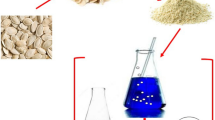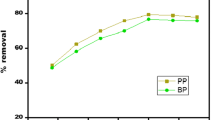Abstract
The use of low-cost and eco-friendly adsorbents has been investigated as an ideal alternative to the current expensive methods of removing dyes from wastewater. In this study, not hydrolyzed poly(styrene-alternative-maleic anhydride) (PSMA) polymer have been used as new synthetic adsorbent to removal of acid red-14 dye from aqueous solutions (industrial wastes). Batch sorption studies have been carried out to determine the effect of agitation time, pH, adsorbent dose, and initial concentration of the sorbate and temperature. The effect of electrolyte interference such as \( {\text{Na}}^{ + } \) and \( {\text{Cl}}^{ - } \) on dyes removal efficiency was investigated. The acid red 14 dye showed maximal amount of sorption capacity as 5.12 mg/g at pH 6.1 and 25 °C. Equilibrium data were fitted with Langmuir and Freundlich isotherms to find the best fit, and it was found that the adsorption of this dye on adsorbents particles are monolayer and correspond to the Langmuir isotherm. Adsorption kinetics were investigated using pseudo-first-order and pseudo-second-order rate equations and kinetic data followed the pseudo-second-order rate equation for sorption of this dye on PSMA adsorbent. The application of adsorbents performance was tested with real samples which contain limit exceeded amount of foresaid dyes which had been taken from a Dyeing Factory. This study provides good background to development of dye removal in waste waters by polymeric sorbent.








Similar content being viewed by others
References
Alley ER (2005) Water quality control handbook, 8, McGraw Hill, 125
Arami M, Yousefi Limaee N, Mahmoodi NM, Salman Tabrizi N (2005) Removal of dyes from colored textile wastewater by orange peel adsorbent: equilibrium and kinetic studies. J Colloid Inter Sci 288:371–376
Arami M, Limaee NY, Mahmoodi NM, Tabrizi NS (2006) Equilibrium and kinetics for the adsorption of direct acid dyes from aqueous solution by soy meal hull. J Hazard Mater B135:171–179
Baban A, Yediler A, Ciliz NK (2010) Integrated water management and CP implementation for wool and textile blend processes. Clean 38(1):84–90
Baocheng Q, Jiti Z, Xuemin X, Chunli Z, Hongxia Z, Xiaobai Z (2008) Adsorption behavior of Azo Dye CI Acid Red 14 in aqueous solution on surface soils. J Environ Sci 20(6):704–709
Benefield LD, Judkins JF, Weand BL (1982) Process chemistry for water and wastewater treatment. Prentice-Hall, Inc, p 191
Daneshvar N, Salari D, Khataee AR (2003) Photocatalytic degradation of azo dye acid red 14 in water: investigation of the effect of operational parameters. J Photochem Photobiol A 157(1):111–116
Daneshvar N, Salari D, Khataee AR (2004) Photocatalytic degradation of azo dye acid red 14 in water on ZnO as an alternative catalyst to TiO2. J Photochem Photobiol A 162(2):317–322
Dobrowski A (2001) Adsorption—from theory to practice. Adv Coll Interface Sci 93:135–224
Ehrlich PR, Ehrlich AH (1972) Population, resources, environment: issues in human ecology, 2nd. W.H.Freeman & Co Ltd, San Francisco, pp 51–75
Feng D, Aldrich C (2004) Adsorption of heavy metals by biomaterials derived from the marine alga Ecklonia maxima. Hydrometallurgy 73(1):1–10
Freundlich HMF (1906) Over the adsorption in solution. J Phys Chem 57:385–471
Garg VK, Moirangthem A, Kumar R, Gupta RR (2004) Basic dye (methylene blue) removal from simulated wastewater by adsorption using Indian Rosewood sawdust: a timber industry waste. Dyes Pigments 63:243–250
Juang RS, Tseng RL, Fu FC (1996) Use of chitin and chitosan in lobster shell wastes for colour removal from aqueous solutions. J Environ Sci Health A31(2):325–338
Langmuir I (1918) The adsorption of gases on plane surfaces of glass, mica and platinum. J Am Chem Soc 40:1361–1403
Liu Y (2008) New insights into pseudo-second-order kinetic equation for adsorption. Coll Surf A Physiochem Eng Asp 320(1–3):275–278
Montanher SF, Oliverira EA, Rollenberg MC (2005) Removal of metal ions from aqueous solutions by sorption onto rice bran. J Hazard Mater B117:207–211
Poots VJP, McKay G, Healy JJ (1978) Removal of basic dye from effluent using wood as an adsorbent. J Water Pollut Control Fed 50:926–939
Robinson T, McMullan G, Marchant R, Nigam P (2001) Remediation of dyes in textile effluent: a critical review on current treatment technologies with a proposed alternative. Bioresour Technol 77:247–255
Shukla A, Zhang YH, Dubey P, Margrave JL, Shukla SS (2002) The role of sawdust in the removal of unwanted materials from water. J Hazard Mater B95:137–152
Sivaraj R, Namasivayam C, Kadirvelu K (2001) Orange peel as an adsorbent in the removal of acid violet 17 (acid dye) from aqueous solutions. Waste Manage 21:105–110
Soloman PA, Basha CA, Ramamurthi V, Koteeswaran K, Balasubramanian N (2009) Electrochemical degradation of Remazol Black B dye effluent. Clean 37(11):889–900
Valderrama C, Cortina JL, Farran A, Gamisans X, de las Heras FX (2008) Evaluation of hyper-cross-linked polymeric sorbents (Macronet MN200 and MN300) on dye (Acid red 14) removal process. React Funct Polym 68(3):679–691
Weber WJ (1972) Physiochemical processes for water quality control. John Wiely, USA, pp 199–236
Woodard F (2001) Industrial waste treatment handbook. Butterworth-Heinemann, p 376
Wu Y, Ma X, Feng M, Liu M (2008) Behavior of chromium and arsenic on activated carbon. J Hazard Mater 159:380–384
Author information
Authors and Affiliations
Corresponding author
Rights and permissions
About this article
Cite this article
Bazrchi, S., Bahram, M. & Nouri, S. Equilibrium and Kinetic Studies on the Removal of Acid Red-14 from Aqueous Solutions Using PSMA. Iran J Sci Technol Trans Sci 42, 203–208 (2018). https://doi.org/10.1007/s40995-018-0489-9
Received:
Accepted:
Published:
Issue Date:
DOI: https://doi.org/10.1007/s40995-018-0489-9




